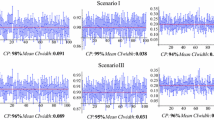Abstract
In this paper, we introduce and study three new start-up demonstration tests with two types of unsuccessful start-ups. The proposed tests use run and frequency quotas acceptance/rejection criteria, providing extensions of binary start-up demonstration tests that have previously appeared in the literature. Using a Markov chain approach we establish general formulas for the distribution of the number of start-ups until the termination of the test, its mean and its variance, as well as for the acceptance probability of the equipment. Numerical results are presented in order to illustrate our method while a practical guidance for the determination of a good start-up demonstration test is also given. Finally, we discuss two inferential procedures for the estimation of the reliability of a single start-up of the test.


Similar content being viewed by others
References
Antzoulakos DL (2001) Waiting times for patterns in a sequence of multistate trials. J Appl Probab 38:508–518
Antzoulakos DL, Rakitzis AC (2008) The modified r out of m control chart. Commun Stat Simul Comput 37:396–480
Antzoulakos DL, Koutras MV, Rakitzis AC (2009) Start-up demonstration tests based on run and scan statistics. J Qual Technol 41:48–59
Balakrishnan N, Chan PS (2000) Start-up demonstration tests with rejection of units upon observing d failures. Ann Inst Stat Math 52:184–196
Balakrishnan N, Balasubramanian K, Viveros R (1995) Start-up demonstration tests under correlation and corrective action. Naval Res Logist 42:1271–1276
Balakrishnan N, Mohanty SG, Aki S (1997) Start-up demonstration tests under Markov dependence model with corrective actions. Ann Inst Stat Math 49:155–169
Balakrishnan N, Bersimis S, Koutras MV (2009) Run and frequency quota rules in process monitoring and acceptance sampling. J Qual Technol 41:66–81
Chan PS, Ng THK, Balakrishnan N (2008) Statistical inference for start-up demonstration tests with rejection of units upon observing d failures. J Appl Stat 35:867–878
Dafnis SD, Philippou AN, Antzoulakos DL (2012) Distributions of patterns of two successes separated by a string of \(k-2\) failures. Stat Pap 53:323–344
Eryilmaz S (2010a) Start-up demonstration tests under Markov dependence. Pak J Stat 26:637–647
Eryilmaz S (2010b) Review of recent advances in reliability of consecutive k-out-of- n and related systems. Proc Inst Mech Eng Part O 224:225–237
Eryilmaz S, Chakraborti S (2008) On start-up demonstration tests under exchangeability. IEEE Trans Reliab 57:627–632
Fu JC (1996) Distribution theory of runs and patterns associated with a sequence of multi-state trials. Stat Sinica 6:957–974
Fu JC, Lou WYW (2003) Distribution theory of runs and patterns and its applications: a finite Markov chain imbedding approach. World Scientific, Singapore
Gera AE (2010) A new start-up demonstration test. IEEE Trans Reliab 59:128–131
Gera AE (2011) A general model for start-up demonstration tests. IEEE Trans Reliab 60:295–304
Gera AE (2013) A general multi-state start-up demonstration testing procedure. Int J Reliab Qual Saf Eng 20. doi:10.1142/S0218539313500137
Hahn GJ, Gage JB (1983) Evaluation of a start-up demonstration test. J Qual Technol 15:103–105
Inoue K, Aki S (2009) On waiting time distributions associated with compound patterns in a sequence of multi-state trials. Ann Inst Stat Math 61:499–516
Koutras MV (1997) Consecutive-k, r-out-of-n: DFM systems. Microelectron Reliab 37:597–603
Koutras MV, Alexandrou VA (1997) Sooner waiting time problems in a sequence of trinary trials. J Appl Probab 34:593–609
Koutras MV, Bersimis S, Maravelakis PE (2007) Statistical process control using Shewhart control charts with supplementary runs rules. Methodol Comput Appl Probab 9:207–224
Lou WYW, Fu JC (2009) On probabilities for complex switching rules in sampling inspection. In: Glaz J, Pozdnyakov V, Wallenstein S (eds) Scan statistics: methods and applications. Birkhauser, Boston, pp 203–219
Makri FS, Philippou AN (2005) On binomial and circular binomial distributions of order \(k\) for \(\ell -\)overlapping success runs of length \(k\). Stat Pap 46:411–432
Makri FS, Psillakis ZM (2012) Exact distributions of constrained \((k,\ell )\) strings of failures between subsequent successes. Stat Pap. doi:10.1007/s00362-012-0462-1
Martin DEK (2004) Markovian start-up demonstration tests with rejection of units upon observing d failures. Eur J Oper Res 155:474–486
Philippou AN, Makri FS (1985) Longest success runs and Fibonacci-type polynomials. Fibonacci Q 23:338–346
Philippou AN, Georghiou C, Philippou GN (1983) A generalized geometric distribution and some properties. Stat Probab Lett 1:171–175
Rakitzis AC, Antzoulakos DL (2011) Chi-square control charts with runs rules. Methodol Comput Appl Probab 13:657–669
Rothenberg TJ (1971) Identification in parametric models. Econometrics 39:577–591
Scollnik DPM (2011) Bayesian inference for a class of start-up demonstration tests with rejection of units upon the observation of d failures. Commun Stat Theory Methods 40:2528–2538
Smith ML, Griffith WS (2003) The analysis and comparison of start-up demonstration tests. Technical Report 391, Department of Statistics, University of Kentucky.
Smith ML, Griffith WS (2005) Start-up demonstration tests based on consecutive success and total failures. J Qual Technol 37:186–198
Smith ML, Griffith WS (2008) The analysis and comparison of start-up demonstration tests. Eur J Oper Res 186:1029–1045
Smith ML, Griffith WS (2011) Multi-state start-up demonstration tests. Int J Reliab Qual Saf Eng 18:99–117
Viveros R, Balakrishnan N (1993) Statistical inference from start-up demonstration tests data. J Qual Technol 22:119–130
Acknowledgments
The authors would like to thank the three anonymous referees for their constructive comments and suggestions that led to significant improvement of the paper.
Author information
Authors and Affiliations
Corresponding author
Rights and permissions
About this article
Cite this article
Rakitzis, A.C., Antzoulakos, D.L. Start-up demonstration tests with three-level classification. Stat Papers 56, 1–21 (2015). https://doi.org/10.1007/s00362-013-0564-4
Received:
Revised:
Published:
Issue Date:
DOI: https://doi.org/10.1007/s00362-013-0564-4
Keywords
- Frequency quotas
- Markov chain imbedding technique
- Maximum likelihood estimation
- Multistate trials
- Quality control
- Reliability testing
- Run quotas
- Waiting-time distribution




